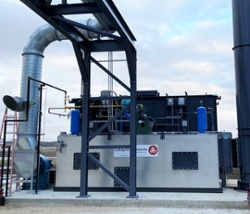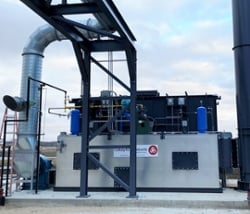Catalytic Products International (CPI) recently installed an 8,000 SCFM Regenerative Thermal Oxidizer (RTO) at a new Midwestern USA railcar manufacturer for the abatement of Volatile Organic Compounds (VOCs) from the interior lining process.

- Process Type: Rail Car Interior Coating / Painting
- VOC: Toluene, MEK, and Xylenes
- Process Air Volume: 8,000 scfm
- Control Type: Regenerative Thermal Oxidizer (RTO)
- Destruction Rate of Efficiency (DRE): 98%
- Installation: Turnkey RTO and Ductwork Install
The 8,000 SCFM TRITON-8.95 Regenerative Thermal Oxidizer (RTO) will control VOC emissions containing, among other things, toluene, MEK, and xylenes, from interior lining booths at the new railcar repair and relining facility. The RTO will control the VOC emissions with 98% destruction rate efficiency (DRE) and 95% thermal efficiency.
Thermal treatment of VOCs and other air pollutants works by a simple reaction of the harmful hydrocarbon-based air pollutants with oxygen and heat. In this environment, the VOCs are oxidized to form harmless inert by-products like CO2, water vapor (H2O), and usable heat. These harmless by-products are released to the atmosphere or used within primary or secondary energy recovery techniques to further lower the operational costs.
CPI Regenerative Thermal Oxidizers (RTOs) are engineered to provide exceptional performance and reliability. During operation of the standard two chamber RTO, the VOCs are directed into one of the system’s regenerators, an internally insulated vessel containing specialized ceramic media which allows thermal rate efficiencies up to 97%. The contaminated gases are passed through the first regenerator where energy is transferred from the ceramic media to the gas in order to elevate the temperature. This elevated temperature approaches the ignition level for most solvents and is then directed from the ceramic bed into the combustion chamber. As the stream exits the ceramic bed and travels through the internally lined combustion chamber, minimal heat is added to ensure a proper oxidation temperature and a designed dwell time is maintained providing destruction of the VOCs at greater than 98% efficiency. The resultant clean, oxidized gases are directed to the second regenerator to absorb the heat energy before being released to the atmosphere.
Based on CPI’s experience with this longtime customer at existing plants, CPI was able to provide a complete turn-key installation including design, supply and installation of the new VOC abatement system. The installation of the RTO and related equipment included interior process ductwork, exhaust system and stack, and dampers. The exhaust system includes elevated galvanized spiral ducting running inside the roof of the building to connect to the main ductwork header, tank car exhaust blowers, dilution air and balancing dampers, and a prefilter in the main exhaust leg to help prevent buildup on the exhaust blower.
CPI has been “Enabling Clean Production Since 1969” and continues as a leading supplier of air pollution control equipment. CPI is at the forefront in providing industries including large surface coating operations with solutions to their air pollution control needs.
Today, CPI partners with its customers as a trusted resource in resolving the most complex air pollution and energy conservation problems. We provide our customers with innovative and cost-conscious solutions to their most complex VOC, NOx, and Odor pollution challenges. Our equipment is also at work meeting energy conservation strategies and minimizing greenhouse gas (GHG) emissions.








